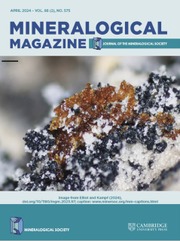No CrossRef data available.
Article contents
Electrum dendrites from the Ametistovoe epithermal deposit, Kamchatka, Russia
Published online by Cambridge University Press: 14 July 2025
Abstract
Electrum dendrites and associated minerals from the Ametistovoe Au–Ag epithermal deposit (Kamchatka) were investigated by optical and electron microscopy, X-ray computed tomography, electron microprobe and electron back-scattered diffraction techniques. Electrum forms dendrites up to 1 mm in size within sphalerite, or, rarely, within galena and chalcopyrite and random particles within quartz. The electrum has a very homogeneous composition (fineness 603 to 615) which correlates neither with the host mineral nor with the electrum morphology. X-ray computed microtomography showed electrum dendrites are 2-dimensional and consist of an acicular ‘trunk’ hosting numerous ‘branches’. 3-dimensional and ‘bush-like’ dendrites are rare. Angles between ‘trunk’ and ‘branches’ are usually 90° and less commonly, 60° suggesting twinning along (100) and (111) planes, respectively. Electron back-scattered diffraction showed the dendrites are single crystals with no defects detected, whereas electrum within quartz has a mosaic texture with low pattern quality. A model proposed for the observed phenomena includes: (1) growth of single-crystal electrum dendrites within silica gel; (2) overgrowth of dendrites by sphalerite crystals; (3) recrystallisation of the opaline silica to crystalline quartz which resulted in destruction of electrum dendrites located within silica and preservation of those hosted by sphalerite. This model proposes crystallisation of electrum dendrites from a hydrothermal solution and implies a critical role for amorphous silica gel as a precursor for dendrite formation.
Information
- Type
- Article
- Information
- Copyright
- © The Author(s), 2025. Published by Cambridge University Press on behalf of The Mineralogical Society of the United Kingdom and Ireland.
Footnotes
Associate Editor: Ferdinando Bosi

